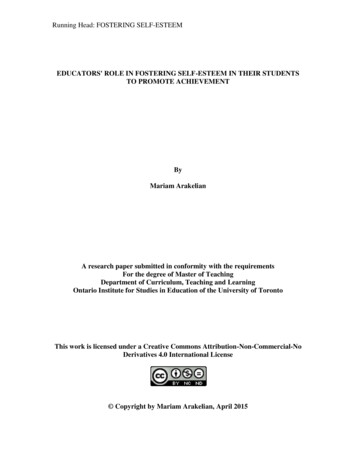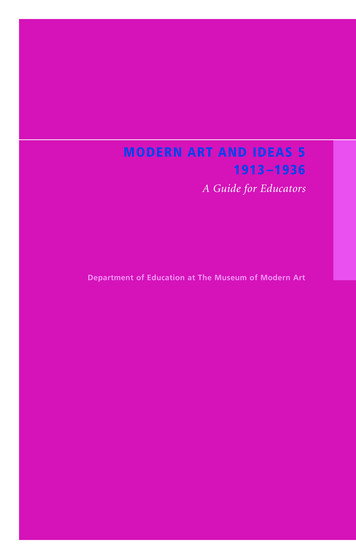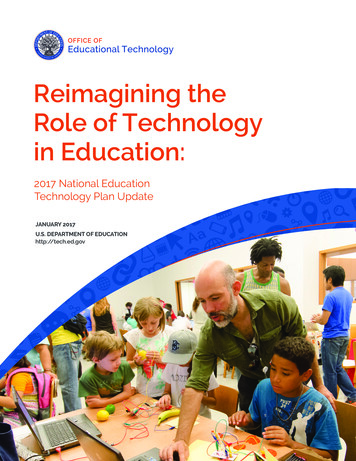
Transcription
Running Head: FOSTERING SELF-ESTEEMEDUCATORS' ROLE IN FOSTERING SELF-ESTEEM IN THEIR STUDENTSTO PROMOTE ACHIEVEMENTByMariam ArakelianA research paper submitted in conformity with the requirementsFor the degree of Master of TeachingDepartment of Curriculum, Teaching and LearningOntario Institute for Studies in Education of the University of TorontoThis work is licensed under a Creative Commons Attribution-Non-Commercial-NoDerivatives 4.0 International License Copyright by Mariam Arakelian, April 2015
FOSTERING SELF-ESTEEMAbstractIn an age of extreme technological and media exposure, children are bombardedwith subliminal indoctrination of messages which place undue value on outwardappearance. This results in constant disappointment and dissatisfaction with one's selfbecause it is impossible to compare or keep up with the false ideals and unattainableexpectations that which society sets. When a child experiences a decrease in self-esteem,he begins to question his self-worth. Further, if unequipped with adequate social and lifeskills, such as self-competence or self-efficacy, he begins to doubt his abilities and hispotential for success. Once his self-confidence is lost, he descends into a state ofperpetual doubt of self-worth and self-love; thus, partaking in a cycle which is difficult tobreak. In turn, educators must implement prevention tactics for students to become moreprepared to face inevitable challenges. This qualitative research study seeks to investigatethe various perceptions, pedagogies, and experiences of two primary and junior teachersfrom Ontario and Quebec who aim to tackle this recurring phenomenon. Through athorough literature review in collaboration with two qualitative interviews, I aim toexplore the ways in which educators implement pedagogies that help foster self-esteem intheir students. The findings of this research should provide educators with practical andtransferrable strategies that can support students' growth and success in all aspects oftheir lives.Keywords: Self-esteem, self-efficacy, self-worth, self-competence, unconditional love,confidence, resilience, life skills, social skills, success, growth, community, primary,junior, academic achievement, character development, character education, mental health2
FOSTERING SELF-ESTEEMAcknowledgementsI wish to first acknowledge and thank God who has given me, and continues togive, counsel, peace, and an unwavering love. for thine is the kingdom, the power, andthe glory, now and forever. I'd like to express my sincere gratitude to my sister, NairyArakelian, who has been an immense inspiration for me, for without her I would not havea research topic that I am extremely passionate about. I'd also like to thank my parents,for their undying support and for the many sacrifices they have had to make to provide agood life for me and my sister.I would also like to express my warm thanks to my research supervisor, who isalso a celebrity in the education field, David Booth, for sharing his wisdom and expertisethroughout this research process. In addition, I give thanks to my professors, Dr. ArloKempf and Dr. Antoinette Gagné, for their extensive feedback, direction, andencouragement. To my participants, thank you for sharing your invaluable insights withpassion and determination. Finally, I express my sincere gratitude to my J/I cohort, myMT instructors, my Associate Teachers, and my friends for their constant support,optimism, and assistance. I have learned a tremendous amount from you. This processwould have been next to impossible without each and every one of you. Thank you.3
FOSTERING SELF-ESTEEMTable of ContentsAbstract . 2Key Words . 2Acknowledgements . 3Chapter 1: INTRODUCTION . 71.1 Introduction to the Research Study . 71.2 Purpose of the Study . 71.3 Research Questions . 81.4 Background of the Researcher . 91.5 Overview . 10Chapter 2: LITERATURE REVIEW . 112.1 Introduction . 112.2 Conceptualizing Self-Esteem . 112.2.1 Self-Esteem Theory.122.2.2 Self-Concept.122.2.3 Self-Efficacy.132.2.4 Interrelated Concepts: Two-Dimensional Model of Self-Esteem.14Table 2.1.162.3 Changes in Self-Esteem During Early Adolescence . 172.3.1 Elementary vs. Middle School Classrooms .172.4 The Importance of Self-Esteem in Education . 182.5 Measuring Self-Esteem . 202.6 Influencing Self-Esteem Through Character Education and Narrative . 202.7 Pedagogical Practices. 252.7.1 Implementing Strategies .25Table 2.2.26Table 2.3.282.8 Conclusion . 30Chapter 3: METHODOLOGY . 313.1 Procedure . 313.2 Instruments of Data Collection . 313.3 Participants . 324
FOSTERING SELF-ESTEEM3.4 Data Collection and Analysis. 323.5 Ethical Review Procedures . 333.6 Limitations . 33Chapter 4: FINDINGS . 354.1 Introduction . 354.2 Conceptualizing Teachers' Perceptions . 364.2.1 Definitions of Self-Esteem.364.2.2 Interrelated Concepts .374.3 Importance of Self-Esteem . 384.3.1 Importance Teacher Education Places on Self-Esteem.384.3.2 Importance Educators Place on Self-Esteem.394.4 Implementing Strategies to Build Self-Esteem . 404.4.1 Instructional Strategies.414.4.2 Environmental Strategies.424.4.3 Assessment.444.4.3.1 Importance of Learning Skills .454.5 Pedagogical Approaches . 464.5.1 Philosophy of Education .464.5.2 Character Development.474.6 Barriers for Fostering Self-Esteem in Students . 484.6.1 Inconsistency.494.6.2 Lack of Support for Differentiation .504.7 Conclusion . 51Chapter 5: DISCUSSION. 535.1 Introduction . 535.2 Interpretation and Evaluation of Findings . 535.2.1 Conceptualizing Self-Esteem.535.2.2 Change in Self-Esteem in Adolescents.545.2.3 Promoting Success.545.2.4 Overcoming Barriers.555.3 Implications and Recommendations . 565.3.1 Role of the Teacher.565
FOSTERING SELF-ESTEEM5.3.2 Role of the Educational Community.575.4 Limitations . 575.5 Further Study . 585.6 Conclusion . 59REFERENCES . 60APPENDICES . 63Appendix A: Letter of Consent for Interview . 63Appendix B: Interview Questions . 656
FOSTERING SELF-ESTEEMChapter 1: INTRODUCTION1.1 Introduction to the Research StudyYoung, Canadian adolescents face many issues regarding their self-image. Earlyadolescence is a crucial time to develop positive self-esteem; however, being bombardedwith implicit and explicit messages from society on what is the ‘ideal’ image, they learnto be very negative and critical about themselves. This topic is a recurring problem and itis becoming more popular, for a lack of better terms, due to the powerful influence ofmedia. According to the American Psychological Association or APA (2007), thewidespread sexualization of people plays a major role in the deterioration of adolescentmental health. Sexualization occurs when a person is valued primarily based on his or hersexual appearance rather than their intelligence or other qualities. Moreover, the APAlinks sexualization with the three most common mental health problems: eating disorders,low self-esteem, and depression. Media such as television and magazines, to name a few,are powerful tools that promote sexualization. Statistics show that 80% of studentsentering school feel good about themselves, but by the 5th grade only 20% of them feelhappy with their image (Grunbaum et al., 2004). In addition, only one out of five highschool students has positive self-esteem (Grunbaum et al., 2004). One cannot help butwonder what is changing as these students get older and why some students are affectedand not others.1.2 Purpose of the StudyThe purpose of this exploratory study is to describe the perceptions and practicesof two primary and junior (grade 1 to 6) teachers who are committed to enhancing7
FOSTERING SELF-ESTEEMstudents' positive self-esteem in Canadian classrooms. Like anxiety, negative self-esteemimpedes student learning. It is important for teachers to tackle this issue at the junior levelso that students can develop a positive self-esteem. According to the Canadian Women'sFoundation (2007), "The best time to teach these skills is between the ages of nine andthirteen." In turn, their level of self-efficacy could potentially rise, which would allowthem to achieve academic success. Self-efficacy predicts the quality of studentfunctioning. Students who doubt their capacity to cope with situational surprises andsetbacks experience anxiety (Bandura, 1988), confusion (Wood & Bandura, 1989),negative thinking (Bandura, 1983), bodily tension, and aversive physiological arousal(Bandura et al., 1985). (O'Donnell, 2008, p. 297). These overwhelming factors contributeto students' mental health, development, and ultimately, their success.1.3 Research QuestionsThrough this study, I explore the perceptions, experiences and teaching strategiesof two primary and junior teachers in Ontario and Quebec who foster the development ofself-esteem in their students. My research sub-questions are: What are teachers' perceptions on developing their students’ self-esteem?What are teachers' experiences in effectively fostering students' self-esteem intheir classrooms?What are educators' perspectives on the impact of self-esteem in their students'learning?Research shows that—with the right help—adolescents can successfully navigateadolescence and avoid the negative patterns of self-objectification, low self-esteem,negative body image, anxiety, depression, and passivity (Canadian Women's Foundation,2007). My goal for this project is to educate teachers in the areas of adolescent selfesteem and how it has an impact on student learning. Moreover, I encourage teachers to8
FOSTERING SELF-ESTEEMtake action by implementing strategies for character development in the curriculum, andmodeling unconditional love so that "[students] begin to learn how to interpret, challenge,and ultimately change the message that their value depends solely on their outwardappearance." (CWF, 2007).1.4 Background of the ResearcherIn 2013, I graduated from Glendon College, York University with a BilingualHonors Bachelor of Arts in English and Sociology. Currently, I am close to completingmy Masters in Teaching degree at OISE of University of Toronto, at theJunior/Intermediate level. Throughout my high school and university career, I haveworked at numerous summer camps, tutored, and taken up other leadership roles whichhave shaped the teacher I am today. My Master of Teaching Research Project (MTRP)topic is of great importance to me because I have a personal connection to it. My sisterdeveloped negative self-esteem in her early adolescent years and this was one of thefactors which affected her academic achievement. I could not fathom how such a brightgirl was failing most of her courses in high school. Whatever was deeply wounding herwas naturally hurting and concerning me as well, but I promised myself that I wouldnever lose hope. For years, my family and I tried everything to help improve her personalsense of self-worth, but we seemed to fail each time. My sister constantly struggled withher body image and she gradually lost confidence in herself and in her abilities. Due tothese personal life experiences, I decided I would do more research on this topic and tryto help children develop positive self-esteem.Fortunately, my sister transferred to an all-girls high school in grade eleven andfelt comfortable there. She developed positive relationships with her teachers and peers.9
FOSTERING SELF-ESTEEMHer self-esteem improved greatly; she became much happier about her image eventhough it had not changed. Consequently, she excelled in her academics, graduated withhonours, and received acceptance for the Criminal Justice program in all the universitiesshe applied for. Currently, she is studying Criminology at Ryerson University withaspirations of becoming a lawyer.Needless to say, I learned a great deal from my sister and I am thankful for that.After all, life experience is the best teacher, but I do not want to stop there. The issue ofself-esteem cultivation has been examined briefly in a few of my academic courses. It isevident that it is an important phenomenon which must be overcome because studentsdeserve a positive academic and social experience.1.5 OverviewThis study is designed to provide additional insight surrounding research on theimplementation of strategies to foster self-esteem in students. The 1st chapter includes theintroduction and purpose of the study, the research questions, as well as the purpose ofmy involvement in this topic and study. The 2nd chapter presents a review of the currentliterature on the concepts of self-esteem, self-efficacy, and academic achievement.Chapter 3 provides the methodology and procedure used in this study includinginformation about the participants and data collection instruments. The 4th chapteridentifies the participants in the study and describes the findings from the data as itaddresses the research question. Finally, the 5th chapter contains the discussion of thefindings, limitations of the study, recommendations for practice, and further reading andstudy. References and a list of appendixes follow at the end.10
FOSTERING SELF-ESTEEMChapter 2: LITERATURE REVIEW2.1 IntroductionThe study of self-esteem has been explored through theoretical and empiricalwork for decades. However, as Miller and Moran (2012) state, "what we believe aboutself-esteem is not supported by research evidence” (p. 4). Before learning how toeffectively enhance students' self-esteem, one must be familiar with its theory. It isimportant to gain insight from extensive literature on self-esteem. It is then essential toput into practice the strategies, supported by research, that effectively enhance selfesteem and ultimately build self-efficacy. In this chapter, I explore the concept of selfesteem and its importance in students' lives through the theoretical lens of Miller andMoran (2012). Moreover, this literature review identifies different factors, conceptionsand misconceptions of self-esteem. It will also examine various pedagogical practices andstrategies related to the fostering of self-esteem, specifically looking at characterdevelopment methods that improve student success.2.2 Conceptualizing Self-EsteemAlthough difficult to define, one must first begin to understand the differencebetween self-esteem, self-concept and self-efficacy in order to better grasp the topicunder study. Whereas self-concept is a description of oneself, self-esteem is an evaluationof oneself (Rosenberg, 1979). How one values him or herself (positively or negatively)determines his or her self-esteem.11
FOSTERING SELF-ESTEEM2.2.1 Self-Esteem TheoryA person's self-esteem, "is partly evaluated on the emotional basis of how otherstreat him or her. It is also partly evaluated on the basis of that person's competence andachievement in different domains" (O'Donnell, 2008, p.104). This provides a two-partdefinition of self-esteem. O’Donnell goes on to further explain that self-esteem "exists asthe sum of evaluated domains of the self-concept" (p.104). Some authors like Rosenberg,Rosenberg, Schooler, and Schoenbach (1995) suggest that there are two types of selfesteem: specific and global self-esteem. Specific self-esteem is most relevant tobehaviour, whereas global self-esteem, also known as general self-concept, is mostrelevant to psychological well-being. It is believed that school marks produce an effect onself-esteem. Global self-esteem has very little effect on marks whereas specific selfesteem has a strong effect on school performance (Rosenberg, Rosenberg, Schooler,Schoenbach, 1995). Charles Horton Cooley (1902) coins the idea of a "looking-glassself" where he argues that how people feel about themselves is influenced by what theybelieve others think of them. People take into consideration the views that others expressabout them, thus informing their thoughts and behaviors. Although the aforementionedtheories attempt to define self-esteem, they do not fully paint a picture of this concept.2.2.2 Self-ConceptSelf-concept is a more global construct that contains many perceptions about theself, including self-efficacy (Gaskill & Woolfolk Hoy, 2002). Although this definitionseems consistent with the notion of self-esteem and self-efficacy, it is quite different.Efficacy beliefs are strong predictors of behavior, but self-concept has weaker predictivepower (Bandura, 1977). The structure of academic self-concept is depicted in a hierarchal12
FOSTERING SELF-ESTEEMmodel by Herbert Marsh and Richard Shavelson (1985) where they link self-esteem andself-concept closely. They claim that general self-concept (or global self-esteem) isinfluenced by judgments people make about themselves, such as academic, social,physical, and emotional aspects, which in turn, is informed by judgments of competencyin each aspect. Furthermore, self-concept is swayed when people identify with rolemodels. A child would imitate a model closest to him, such as a parent. If the parent has ahealthy self-esteem, then it is expected that the child would imitate the same mentality,thus contributing to the child's own self-concept.2.2.3 Self-EfficacySelf-efficacy, on the other hand, is "one's judgment of how well one will copewith a situation, given the skills one possesses and the circumstances one faces"(O'Donnell, 2008, p. 296). Pearson (2008) argues that there are two types of self-efficacy:self-efficacy theory and academic self-efficacy. Academic self-efficacy refers to one'sperceived ability to perform academic tasks at desired levels (Pajares & Miller, 1994;Schunk, 1991; Pearson, 2008). According to Bandura (1977), the behaviour on whichpeople base their beliefs can be developed by four forms of influence: (a) enactedmastery influence, (b) vicarious influence, (c) physiological and emotional influences,and (d) verbal and social persuasion influence (Pearson, 2008). The most influentialsource of perceived self-efficacy is the enacted mastery influence experience becausesuccessful experiences provide tangible evidence that one can accomplish the behaviorand can manage whatever it takes to succeed in spite of circumstances (Pearson, 2008).However, students must be taught that "a resilient sense of efficacy requires experience inovercoming obstacles through perseverant effort" (Bandura, 1995, p. 3). In their13
FOSTERING SELF-ESTEEMlongitudinal study, Rosenberg, et al. (1995) were able to find that school markssignificantly affect self-confidence. Students must learn that they may not always getimmediate results and that success will not always come easy. They may have to workdiligently to achieve their goals.2.2.4 Interrelated Concepts: Two-Dimensional Model of Self-EsteemCompared with self-esteem, self-efficacy is concerned with judgments of personalcapabilities; self-esteem is concerned with judgments of self-worth (Gaskill & WoolfolkHoy, 2002). For example, if students have not developed strong self-efficacy, then theirself-esteem easily gets destroyed and their motivation in academics deteriorates. On theother hand, if a student has positive self-esteem, then he or she will more likely developstrong self-efficacy. However, Gaskill and Woolfolk Hoy, state that "it is possible to feelhighly efficacious in one area and still not have a high level of self-esteem, or viceversa." (2002, p. 186). They further argue that "if you were a teacher and your selfefficacy for teaching started dropping after several bad experiences, it is likely that yourself-esteem would suffer too" (2002, p.186). In this case, self-efficacy for a particulartask affects self-esteem only if the person values that task. This is not any different thanthe type of experience a student has in school. If a student's self-efficacy started droppingafter receiving a few bad grades, then his or her self-esteem would likely be affected too.In my research, I explore the notion of self-esteem through the theoretical lens ofChristopher Mruk (1999) and Moran and Miller (2012). When I use the term self-esteem,it essentially is encompassing the concept of self-efficacy. Mruk (1999) offers a view,that which he introduces a two-dimensional model of self-esteem and how it is comprised14
FOSTERING SELF-ESTEEMof two interrelated components: self-worth and self-competence. For my study, I will usethis model of self-esteem as a conceptual framework. Miller and Moran (2012) furtherexplain this idea in their own terms:This reflects a fundamental belief that how we feel about ourselves is dependenton two types of judgment, linked to two aspects of the 'value' of a person. Theseare the intrinsic worth of the individual (what we are), and the instrumental value(what we can do). The former relates largely to aspects of character, the latter tocompetence (p.5).A sense of worthiness is established by how one sees himself and how others perceivehim. If he is seen in a positive light, as a likeable and honourable man, for example, thenhe is more likely to feel a sense of worthiness. Moreover, self-competence is determinedby how well man copes with adversity. Bandura's (1992) work on self-efficacy closelyresembles Mruk's idea of self-competence - two terms that I will use interchangeablythroughout my study.Alternatively, there has been much debate about the interchangeability of theconcepts of self-esteem and self-efficacy. While the former is believed to be an affectivephenomenon, the latter is perceived to be cognitive. However, Miller and Moran arguethat the two-dimensional model of self-esteem "involves the belief that coping with thechallenges one faces in life (or failing to do so) carries with it subjective feelings aboutthe self" (2012, p.6). Evidently, the notion of success or failure results in having apositive or negative feeling and it influences one to feel a certain way about oneself.Therefore, "self-competence is more than just the imprint of efficacy; it is both thecognitive recognition of my success or failure and how I feel about it" (p.6). Thus, if onehas low self-competence and self-worth, then one has low self-esteem. Below is a table of15
FOSTERING SELF-ESTEEMterms taken from Miller and Moran's (2012) book Self-Esteem: A Guide for Teachers,which helps readers better understand these concepts.Table 2.1 Miller & Moran (2012) Visual Conceptualization of Terms16
FOSTERING SELF-ESTEEM2.3 Changes in Self-Esteem During Early AdolescenceEarly on, children develop their personal theories of schooling, often based onsocial interactions in the classroom. These theories influence their actions at school andeither foster or impede academic achievement (Gaskill & Woolfolk Hoy, 2002). Wigfieldand Eccles' (2002) study found the following:The early adolescent developmental period is one in which individuals experiencemany changes, including the biological changes associated with puberty,important changes in relations with family and peers, and the social andeducational changes resulting from transitions from elementary to junior highschool. (p. 159)Different theorists have proposed that these changes have significant impact on a varietyof developmental outcomes. Gaskill and Woolfolk Hoy (2002) argue that "Besidesbeliefs about their academic abilities, [students] also form beliefs about the nature ofacademic tasks, cognitive strategies, social dispositions of others, and expectations fortheir own success." (p. 189). Children's beliefs influence their attitude towards life andschool.2.3.1 Elementary vs. Middle School ClassroomsChanges in early adolescents' motivation and self-concepts are influenced bydifferent experiences in middle schools (Wigfield & Eccles, 2002). One of the changes isin authority relationships in which Wigfield and Eccles argue:Middle school classrooms, as opposed to elementary school classrooms, arecharacterized by a greater emphasis on teacher control and discipline and feweropportunities for student decision making, choice, and self-management. (p. 167)These practices, which can reduce students' sense of control and autonomy, can alsoaffect students' self-efficacy.17
FOSTERING SELF-ESTEEMSecond, research has noted a shift in the classroom environments from elementaryto middle school which can affect students’ self-efficacy. Middle school classrooms areoften characterized by less personal teacher-student relationships. Elementary schoolclassrooms are depicted as the opposite where positive and emotionally warm relationswith teachers influences students' motivation and adjustment in the classroom (Wigfield& Eccles, 2002). Children entering first grade already show a wide range of ind
Her self-esteem improved greatly; she became much happier about her image even though it had not changed. Consequently, she excelled in her academics, graduated with honours, and received acceptance for the Criminal Justice program in all the universities she applied for. Currentl










